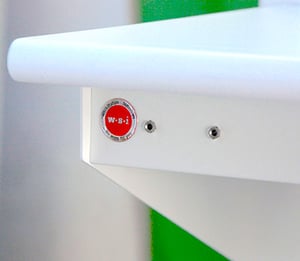As businesses increasingly rely on complex electronic devices in all areas of their operations, the damage caused by a silent culprit can derail a company’s functionality in a fraction of a second.
Electrostatic discharge (ESD) is a great concern for companies in a variety of industries, from electronic assembly to aerospace manufacturing, telecommunications and medical device production.
If your business falls in an industry where ESD concerns should be prioritized, you may be looking for ways to mitigate these dangers within your workspace. One of the most effective methods is by taking a closer look at the pieces in your workspace, including your workstations and chairs.
From the countertops your employees work on to the chairs they sit on, industrial furniture can be modified to include ESD protections.
But are industrial ESD workbenches right for your workspace? Here’s what you need to know before you make a significant investment by buying an ESD workbench.
What is ESD?
Before diving in, for those that are just learning about ESD, or purchasing managers that are unfamiliar with the technical aspects of ESD, here is a brief description of the problem.
aspects of ESD, here is a brief description of the problem.
Electrostatic discharge is a natural occurrence in which electricity is passed through our body, or other conductor, and discharges onto some object. For example, the shock we feel when we touch a doorknob is an ESD.
It is a problem for many industries. For example, static discharge can ignite flammable mixtures or vapors in laboratories, and damage sensitive and expensive electronic components in electronics manufacturing. It can attract contaminants in clean environments or cause products to stick together, interfering with the manufacturing process.
Static discharge isn’t something you can see with the naked eye. Often, the damage is done before you even know there is a problem. In fact, static discharge can cause damage to sensitive devices with as little as 1 volt of electricity. Some devices need about 100 volts before they are damaged beyond repair. Others can’t even afford to sustain small amounts of voltage.
For industries that depend on the reliability of components working in extreme conditions, like aerospace manufacturing, the need for a good ESD workstation is paramount.
In some cases, manufacturers may have no idea if a static charge in the manufacturing process has damaged an assembled part unless they test all components one by one or see it fail in the end product. For products related to space exploration, a failed part can be catastrophic.
As you can see, ESD can become a big problem.
How ESD Furniture Prevents Damage
ESD furniture is designed to prevent the build-up and discharge of static electricity, which can be harmful to sensitive electronic components in industrial and laboratory environments. Here are some key features and mechanisms by which ESD furniture helps prevent damage:
- Conductive Materials: ESD furniture is often constructed using materials that have inherent conductivity, such as metals or conductive polymers. These materials facilitate the dissipation of static charges, preventing the accumulation of electric potential on the surfaces.
- Grounding: ESD furniture may be connected to a grounding system. Grounding ensures that any static charge generated on the furniture is safely and quickly dissipated into the ground, preventing the charge from building up and causing a discharge.
- Static Dissipative Surfaces: The surfaces of ESD furniture are often treated or coated with static dissipative materials. Materials like ESD laminate surfaces help to control the rate of static charge dissipation, preventing rapid discharges that could damage sensitive electronic components.
- Ionization Systems: In some cases, ionization systems may be employed in conjunction with ESD furniture. These systems release ions into the air, neutralizing static charges on surfaces and preventing the occurrence of ESD events.
By incorporating these features, ESD furniture provides a controlled environment that minimizes the risk of electrostatic discharge, thereby protecting electronic components, instruments and devices in industrial and laboratory settings. This is crucial in environments where the production or testing of sensitive electronic equipment takes place.
Finding the Right ESD Workbench Partner
Finding the right manufacturing partner for your next ESD workbench purchase involves investigating product quality, customization, lead times and of course price.
Product Quality
When shopping for any ESD product the primary concern should be the quality of the product that you are purchasing.
For an ESD table, the bench top should be manufactured with high quality ESD Laminate with an embedded carbon layer for dissipation of static. ESD dissipation rates should be greater than 10/6th but less than 10/9th and be capable of handling 100,000 ohms.
ESD bench tops can be assembled to any type of frame, but typically high quality steel frames with grounding bolts attached to each end of the table provide the most strength and flexibility, and will provide the longest product life cycle.
Your manufacturing partner should have a good track record of creating quality products that can withstand the rigors of your workplace demands.
Customization
A manufacturer that has the ability to customize your workbench purchase can be another important factor.
The typical bench top has a rolled front end for safety and comfort with squared edges on the other three sides. However, a good manufacturing partner has the ability to customize shapes and sizes to accommodate different customer needs.
Other customization opportunities may include an adjustable height workbench, integrated storage solutions and personalized accessories like an ESD mat.
Don’t forget your ESD chair can be customized as well, with options that include material, adjustability, casters, weight capacity, arm rests and other accessories.
Lead Times
One of the most important factors in selecting a manufacturer for any project is product lead times. Once you place your order, how soon will the product arrive at your facility for assembly.
For tight deadlines receiving the shipment of your furniture may be the most important factor in deciding between two qualified candidates. Domestic manufacturers have a significant advantage over their foreign counterparts.
Lead times can be significantly reduced when you don’t have the added layer of complexity of international shipping to contend with. Working with a domestic manufacturer minimizes the risk of working with a cheaper foreign manufacturer to complete your project on time.
Cost
For many lab or manufacturing managers, cost is the ultimate deciding factor in a product purchase. For ESD workbenches, there is extra cost associated with ESD laminate. You can expect to pay about 15% to 30% more for an ESD product over its non-ESD counterpart. This cost is attributed to time and materials required in the manufacturing process of your tops.
It’s important not to scrimp on an ESD purchase. For sophisticated manufacturers, product failures due to an inferior ESD workbench can be costlier in lost parts in the manufacturing process then a few dollars saved on a cheaper workbench.
Also if you have existing ESD workbenches currently in use that are damaged or in need of repair due to harsh conditions in your facilities, it is wiser and more cost effective to replace the tops rather than attempting to resurface existing tops. The labor rate to resurface existing tops is greater than a purchase of brand new ESD Laminate workbench tops.
Make sure that you look for a manufacturing partner that has all of these attributes. Quality products, customization to meet your needs, short lead times and competitive pricing.
Speak with an ESD expert to get your job done right.


